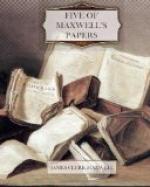When we shall be able to employ in scientific education, not only the trained attention of the student, and his familiarity with symbols, but the keenness of his eye, the quickness of his ear, the delicacy of his touch, and the adroitness of his fingers, we shall not only extend our influence over a class of men who are not fond of cold abstractions, but, by opening at once all the gateways of knowledge, we shall ensure the association of the doctrines of science with those elementary sensations which form the obscure background of all our conscious thoughts, and which lend a vividness and relief to ideas, which, when presented as mere abstract terms, are apt to fade entirely from the memory.
In a course of Experimental Physics we may consider either the Physics or the Experiments as the leading feature. We may either employ the experiments to illustrate the phenomena of a particular branch of Physics, or we may make some physical research in order to exemplify a particular experimental method. In the order of time, we should begin, in the Lecture Room, with a course of lectures on some branch of Physics aided by experiments of illustration, and conclude, in the Laboratory, with a course of experiments of research.
Let me say a few words on these two classes of experiments,—Experiments of Illustration and Experiments of Research. The aim of an experiment of illustration is to throw light upon some scientific idea so that the student may be enabled to grasp it. The circumstances of the experiment are so arranged that the phenomenon which we wish to observe or to exhibit is brought into prominence, instead of being obscured and entangled among other phenomena, as it is when it occurs in the ordinary course of nature. To exhibit illustrative experiments, to encourage others to make them, and to cultivate in every way the ideas on which they throw light, forms an important part of our duty. The simpler the materials of an illustrative experiment, and the more familiar they are to the student, the more thoroughly is he likely to acquire the idea which it is meant to illustrate. The educational value of such experiments is often inversely proportional to the complexity of the apparatus. The student who uses home-made apparatus, which is always going wrong, often learns more than one who has the use of carefully adjusted instruments, to which he is apt to trust, and which he dares not take to pieces.




